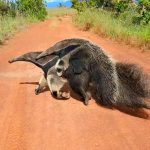First Published: 2nd of May, 2020 by Patrick Carpen.
Last updated: June 3, 2024 at 18:52 pmScientific Name: Moringa Oleifera
Common Names: Saijan, Drumstick, Horseradish
“Saijan bhajee” as it is commonly called by the locals in Guyana, is in fact the world renowned superfood, moringa leaves. Moringa, the subject of a US scientific study around the year 2010, has been classified as a superfood and is used to fight malnutrition as well as for its medicinal value in various parts of the world. The recently developed moringa industry – which sells moringa based products such as moringa power and seeds, is a billion dollar industry.
The Saijan Tree – Untold Riches in the Midst of Poverty
In post-colonial Guyana, the majority of the Guyanese population were financially poor. As a result, they learned to “eat cheap.” For many families, fishing and farming helped to supplement income from jobs.
The moringa tree was commonly known by Guyanese as the saijan tree – an adaptation from Hindi language and culture. The leaves of this tree are often cooked and incorporated into meals in the East Indian culture. The use of moringa as a food product was also known amongst the Africans of Guyana. Evidence suggests little association of the moringa tree with indigenous, Chinese, Portuguese or European food cultures.
Growing easily as wild bush on hard ground in the hot tropics of Guyana, the saijan leaves were easily acquired at a cheap price or, in many cases, free of charge. Many Guyanese have a saijan tree growing in their yard. The leaves of the tree, when harvested for cooking, are called “saijan bhajee” and interestingly were widely considered “poor people’s food” by the local people who didn’t actually know the value which lie hidden in those leaves.
Little did Guyanese know that they were in fact eating something that all the money in the world can’t buy. You’ve probably heard the saying that “the best things in life are free.” The Moringa (saijan) tree is a good example of that. In fact, recent scientific research around the world has dubbed the moringa tree, like the coconut tree, as the “miracle tree” or the “tree of life.”
The Scientific Unraveling
In 2010, Lisa Curtis, a Peace Corp volunteer in Africa, hadn’t been feeling well for several months. She suspected that her diet might have had something to do with it. The villagers introduced her to moringa leaves (saijan). Within a few days, her energy levels began to soar.
Lisa Curtis was so amazed by the results of eating moringa leaves that she subsequently launched a scientific investigation into the moringa leaves. The results were astounding and the moringa leaves were soon classified as a “superfood.” Lisa Curtis subsequently founded the billion dollar superfood supplements company, “Kuli Kuli,” which produces nutritional supplements derived from the moringa tree.
Nutritional and Medicinal Value of Moringa Leaves (Saijan Bhajee)
Calcium – Moringa leaves are rich in calcium. In fact, it contains twice the calcium of milk.
Vitamin C – Moringa leaves have seven times more vitamin C than oranges.
Potassium – Moringa leaves contain 15 times more potassium than bananas.
Antioxidants – Moringa leaves are packed with antioxidants – substances which boost the immune system, protect body cells from damage, lower fat in blood, and reduce blood pressure.
Kills Cancer Cells – Lab studies have proven that moringa leaves kill cancer cells and they have been used to treat cancer patients.
Muscle Building – The high protein, calcium, iron, and amino acids content of moringa leaves support muscle building.
And much more.
If this article inspired you to incorporate your favorite “saijan bhajee” recipe into your next meal, then share it to inspire others!
Reference:
























